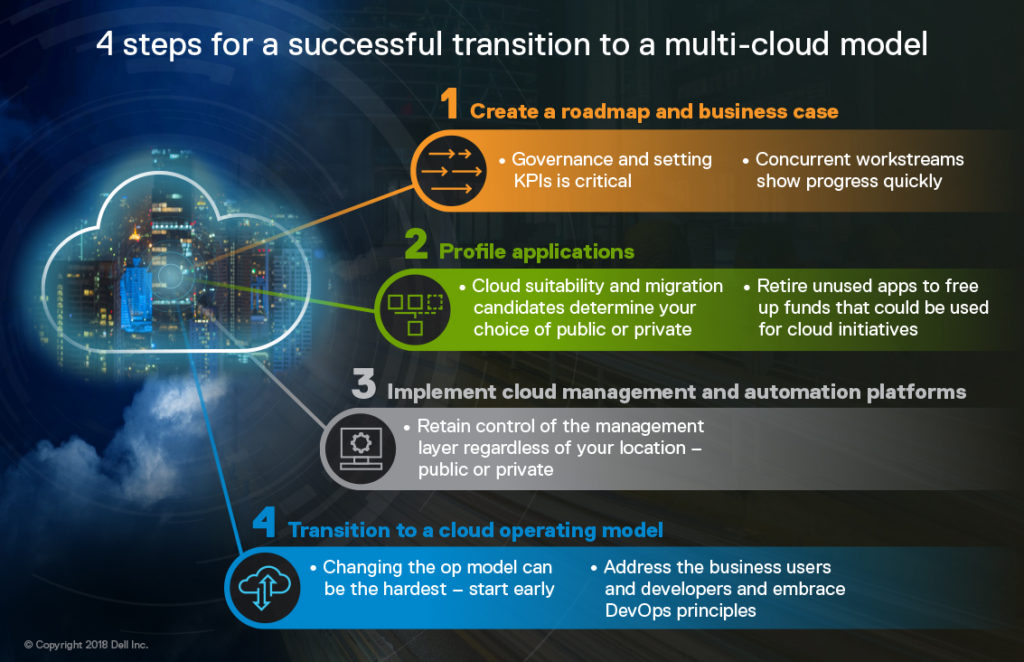Moving to a multi-cloud model doesn’t happen overnight. But some organizations have more delays or false starts than others. There can be several reasons why progress may seem to be elusive. The one we see most frequently is trying to build a cloud environment without clearly defined objectives and without a plan (often using snowflakes). Dell Consulting has prevented a lot of customers from making this mistake and helped them speed their deployments.
4 Steps for a Successful Transition to a Multi-cloud Model:

1 – Create a Roadmap and Business Case
Savvy CIOs want to enable business and application owners to quickly consume the new IT services provided by the cloud. Our successful customers define a set of outcomes and key performance indicators (KPIs) and create a series of rapid, functional releases, organized around delivering minimally viable products (MVPs) that simultaneously drive infrastructure, application, and operating model changes forward. See a sample best practice multi-cloud roadmap in Figure 2. When we build these for customers, we assess the current state, create a future-state vision, define the journey, create key metrics, and project the savings. The result is a business case with an ROI and roadmap (see Figure 2).

2 – Profile Applications
With a roadmap defined, your choice of cloud platform will be driven by your applications. To eliminate the possibility of an expensive mistake, you’ll want to quickly profile your applications to determine which ones should be modernized, migrated, retired, or simply left on their existing infrastructure. You’ll want to use a consistent, repeatable framework for evaluation, so that you can analyze apps in groups. See how this iterative process is executed in Figure 3.
At Dell, we use a proprietary tool-based methodology that identifies and weights critical business priorities to provide an accurate view of the business importance of individual apps in the portfolio. This determines which applications to prioritize for cloud suitability. We use functional, technical, and business attributes for cloud selection. The recommended destinations for each application include a relative cloud fit index describing how easily the application may be migrated. Our tool has a library of common targets, and we can also easily tailor the evaluation characteristics to the customer’s specific destinations, such as a custom private cloud or other modern infrastructure. Based on this analysis, applications are prioritized into groups that are migrated to the new cloud or retired and archived, as shown in Figure 3.

3 – Implement Cloud Management and Automation Platforms
While you’re profiling your applications, you’ll want to be building your private cloud platforms. We use VMware Cloud Foundation™, VMware vRealize® Suite, and VMware NSX®. Using these enables the seamless extension of private clouds to public clouds as well as enables you to securely connect and manage multiple on-premises cloud solutions, all in a common operating environment. As needs change, this architecture can provide an exit strategy for moving applications and workloads from the public cloud back on-premises.
4 – Transition to a Cloud Operating Model
Changing the operating model is probably the most difficult part of transformation. You need to create IT roles and processes for managing the lifecycle of your new, automated IT services and for working with the business to understand their needs. Don’t wait to design your roles and processes until after the infrastructure is in place. That will be too late. Define the essential processes and roles for a service-based organization, particularly for initial infrastructure as a service (IaaS) services, early.
If your cloud platform is also going to serve developers and support platform as a service (PaaS), start identifying those roles and processes early too. If one of your key metrics for your cloud is to release software product updates on a more frequent basis, then you will need to adopt DevOps principles. Some of the IT staff (application operations) will need to work as part of the software product team to create a continuous delivery pipeline to build, test, deploy, and promote cloud-based apps. See the functions of a multi-cloud operating model in Figure 4.

In Closing
What are the next steps?
In addition to the links above, the new Dell Cloud Marketplace is a great resource.
And when you’re ready to get started, reach out to your Dell representative.
If you have any comments or question feel free to comment below.


